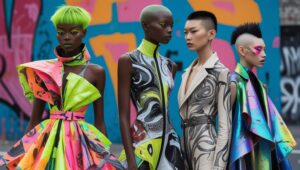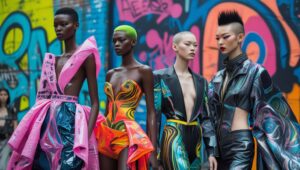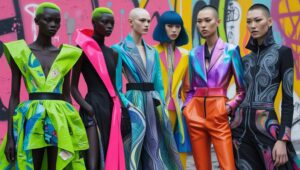Introduction

Fashion has always been a powerful tool for expressing individuality, creativity, and identity. Of all the fashion styles and movements, avant-garde is the boldest. It is original and challenges conventions. The term “avant-garde” comes from the French language and means “advance guard.” It often describes innovative, experimental ideas in art, culture, and fashion. In the U.S., avant-garde fashion is a unique creative expression. It has had a significant impact on the fashion industry and popular culture.
What is avant-garde fashion?
Avant-garde fashion is not about following trends or conforming to mainstream styles. Instead, it is about pushing boundaries and redefining what clothing can be. This style often uses unusual materials and designs. It creates dramatic, artistic pieces that are more wearable art than clothes. Avant-garde fashion challenges traditional views on beauty and utility. It urges people to rethink how they dress.
The Roots of Avant-Garde Fashion in the U.S.A.
The U.S. has a rich history of artistic and cultural movements. They paved the way for avant-garde fashion. In the mid-20th century, American designers began to experiment with bold ideas. European avant-garde movements influenced them. Designers like Elsa Schiaparelli, who worked in Europe, inspired global trends. They helped introduce surrealist and unconventional elements into fashion. Meanwhile, American designers like Charles James and Claire McCardell pushed boundaries in fashion. They focused on innovative construction and functionality.
The 1960s and 1970s were a turning point in American fashion. Counterculture movements embraced nontraditional clothing styles. Fashion designers began to create pieces that reflected the times. They blended art with clothing in a bold, avant-garde manner.
Key Elements of Avant-Garde Fashion
Several key elements characterize avant-garde fashion and make it unique:
- Unconventional Materials: Designers often use unexpected materials to create garments. These include metal, plastic, paper, and recycled objects. These materials challenge what designers should use to make clothes. They expand the possibilities of design.
- Bold Shapes and Structures: Avant-garde fashion has exaggerated silhouettes and sharp, asymmetrical designs. These pieces often look more like sculptures than traditional garments.
- Experimental Techniques: Avant-garde fashion often uses deconstruction, layering, and 3D printing. These methods allow designers to push the limits of traditional garment making.
- Concept-Driven Designs: Avant-garde fashion is often inspired by abstract concepts or social issues. Designers use clothing as a medium to express ideas, tell stories, or make statements.
- Rebellion Against Norms: Avant-garde fashion rejects conventional standards of beauty and practicality. It often challenges gender norms, traditional dress codes, and other societal expectations.
Prominent avant-garde designers in the U.S.
The U.S. has many avant-garde designers. They have made a significant impact on fashion. Here are some of the most influential figures:
- Rick Owens: The “Lord of Darkness” in fashion. He blends gothic and futuristic styles in his designs. His work often features muted colors, oversized silhouettes, and unconventional materials.
People know Thom Browne for his avant-garde approach to tailoring. He reimagines classic menswear by playing with proportions and adding unexpected details.
- Iris van Herpen: Based in Europe, her influence is strong in American fashion. Her use of 3D printing and innovative materials has inspired many U.S. designers.
- Rei Kawakubo (Comme des Garçons): She’s not American, but her work has influenced U.S. avant-garde fashion. Her deconstructed designs and concepts have inspired many American designers and artists.
The Role of Avant-Garde Fashion in American Culture
Avant-garde fashion has played a critical role in shaping American culture. It is often seen on the runways of New York Fashion Week. There, designers showcase bold and innovative collections. These shows challenge norms and introduce new ideas to fashion.
Avant-garde styles have influenced high fashion, streetwear, and everyday clothing. Mainstream fashion now accepts avant-garde ideas. It shows in trends like oversized silhouettes, asymmetry, and experimental fabrics.
Celebrities and artists have embraced avant-garde fashion, boosting its popularity. Bold, unique fashion defines Lady Gaga, Kanye West, and Billie Eilish. They often draw inspiration from avant-garde styles. These public figures use their clothing to make bold statements. They express their individuality and bring avant-garde fashion into the spotlight.
Challenges and Criticisms

Despite its influence, avant-garde fashion is not without its challenges. A common criticism is its high cost and impracticality. This makes it inaccessible to most people. Many avant-garde pieces aim for artistic expression, not everyday wear. So, they are hard to fit into regular wardrobes.
Another challenge is the perception that avant-garde fashion is too abstract or elitist. Some see it as out of touch with everyday consumers. This can limit its appeal.
Yet, these criticisms are also part of what makes avant-garde fashion unique. Avant-garde designers resist commercial pressures. They preserve their freedom and push fashion’s limits.
The Future of Avant-Garde Fashion in the U.S.A.
The future of avant-garde fashion in the U.S. looks bright. Technology is advancing. People now value creativity and individuality more. 3D printing, smart textiles, and sustainable materials are new tools for avant-garde designers. These technologies enable more experimentation. They could make avant-garde fashion more accessible.
Also, social media now lets avant-garde designers share their work worldwide. Platforms like Instagram and TikTok let designers connect with fashion fans. They can showcase their work in new, exciting ways.
Fast fashion describes a model in the clothing industry. It focuses on the rapid production of trendy clothes at low prices. This industry has grown significantly in the U.S. and worldwide. Fast fashion makes clothes accessible to many. But it harms workers, the environment, and society. This article will explore fast fashion. It will cover its rise in the U.S.A., its benefits, and its challenges.
What is fast fashion?
Fast fashion is the mass production of clothes inspired by the latest runway trends. Manufacturers make and ship these clothes to stores on time to meet demand. Brands like Zara, H&M, and Forever 21 are popular examples of fast fashion companies. They create new collections many times a year, sometimes weekly. This is to keep up with changing fashion trends.
Fast fashion relies on low production costs and fast turnaround times. This means that garments are often made with cheap materials, like synthetic fabrics. Countries with low labor costs manufacture them. It makes clothing cheap, but it fosters overconsumption and waste.
The Rise of Fast Fashion in the U.S.
Fast fashion became popular in the United States in the late 20th century. As globalization increased, clothing companies began outsourcing production to countries with cheaper labor. This allowed them to reduce costs and produce large quantities of clothing quickly.
In the 1990s and early 2000s, fast fashion brands began to dominate the U.S. retail market. They sold stylish, cheap clothing. It made fashion accessible to more people than ever. The rise of social media also played a key role. Instagram pushed users to wear the latest styles. This drove demand for new, cheap clothes.
Fast fashion is a multi-billion-dollar industry in the U.S. Today, Americans buy more clothes than ever. But they often discard them after a few wears. This has created a culture of disposable fashion.
The Benefits of Fast Fashion
Fast fashion has several advantages that have contributed to its popularity:
- Affordability: Fast fashion makes stylish clothing affordable for people from all income levels. Consumers can sell trendy items without spending a lot of money.
- Variety: Fast fashion brands offer a wide range of styles, colors, and designs. This allows consumers to find clothing that suits their personal tastes and preferences.
- Accessibility: These brands are easy to find. They are in malls, online stores, and local shops. Customers can sell their products with minimal effort.
The Dark Side of Fast Fashion
Despite its benefits, fast fashion has significant downsides. These include environmental damage, poor labor practices, and negative social impacts.
Environmental Impact
Fast fashion is one of the most polluting industries in the world. Here are some of the ways it harms the environment:
- Textile Waste: The fast fashion model encourages overproduction and overconsumption. As a result, millions of tons of clothing end up in landfills each year. Synthetic fabrics, like polyester, take hundreds of years to decompose.
- Water Usage: Producing clothes, especially cotton garments, requires a significant amount of water. For example, making one cotton shirt can use up to 2,700 liters of water. This puts pressure on freshwater resources.
- Chemical Pollution: The dyes and chemicals in clothing can pollute rivers and soil. Many of these chemicals are harmful to both humans and wildlife.
- Carbon Emissions: Fast fashion’s production and transport emit greenhouse gases. Factories often use fossil fuels. Shipping clothes worldwide adds to the carbon footprint.
Labor Issues
. This leads to:
- Low Wages: Workers are often paid very low wages that do not cover basic living expenses.
- Poor Working Conditions: Many factories are unsafe. They have long hours and ignore worker safety. Incidents like the 2013 Rana Plaza collapse in Bangladesh highlight these issues.
- Child labor: In some cases, children work in garment factories. This deprives them of an education and exposes them to hazards.
Social Impact
Fast fashion promotes a culture of constant consumption. Ads and social media influencers urge people to buy more clothes, even if they do not need them. It wastes resources and prioritizes materialism over sustainability.
The Shift Towards Sustainable Fashion
In recent years, awareness of the negative effects of fast fashion has grown. Many consumers are now seeking alternatives, and sustainable fashion is gaining popularity.
What is sustainable fashion?
Sustainable fashion aims to create clothes that focus on environmental friendliness and fairness.
Steps Toward Sustainability
Sustainable brands use eco-friendly fabrics such as organic cotton, recycled polyester, and bamboo. This reduces their environmental impact.
- Fair Trade Practices: These brands pay workers fair wages. They ensure safe working conditions.
- Recycling Programs: Some companies recycle old clothes into new items.
- Minimalist Fashion: It urges consumers to buy fewer high-quality items. They last longer and reduce waste.
Brands Leading the Way
Several companies in the USA are taking steps toward sustainability. Brands like Patagonia, Everlane, and Reformation focus on ethical production and transparency. Their products cost more. But, they are a sustainable alternative to fast fashion.
What Can Consumers Do?
Consumers play a crucial role in reducing the impact of fast fashion. Here are some ways to make more sustainable choices:
- Buy Less: Focus on quality over quantity. Select timeless pieces that you can wear for years.
- Shop Secondhand: Thrift stores, consignment shops, and resale sites like Poshmark and ThredUp are cheap and eco-friendly.
- Support Sustainable Brands: Sell clothes produced by ethical, eco-friendly companies.
- Care for Your Clothes: Proper washing, storing, and repairing can make them last longer. This reduces the need to buy new items.
- Educate yourself: Learn how your purchases affect the world. Tell your friends and family.
.
Conclusion
Avant-garde fashion in the USA shows the power of creativity. It also shows the need to challenge norms. Avant-garde designers push fashion’s limits. They inspire us to rethink self-expression through clothing. Avant-garde fashion is key to the future of the industry. It sets trends and drives innovation. But it may not be practical or accessible. As technology and culture evolve, avant-garde fashion will inspire and drive style.sion

